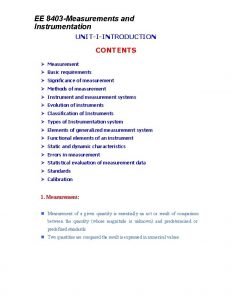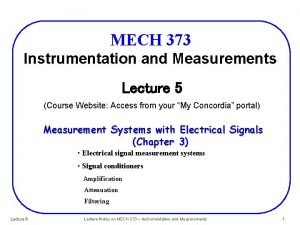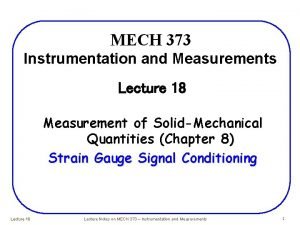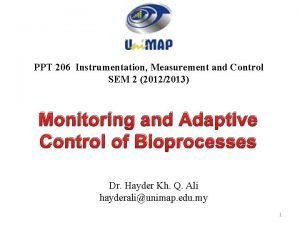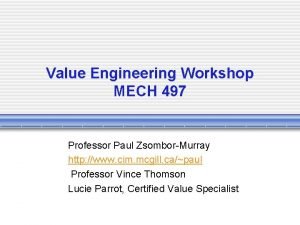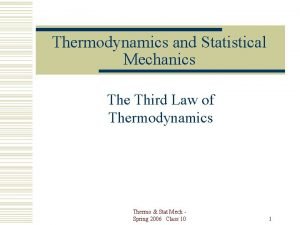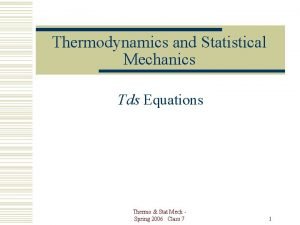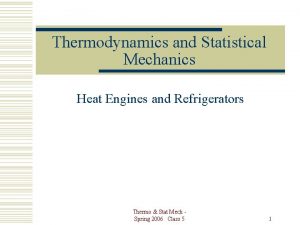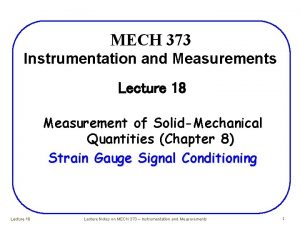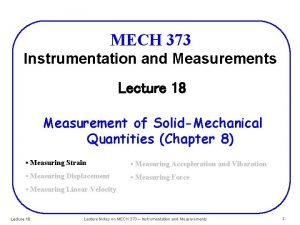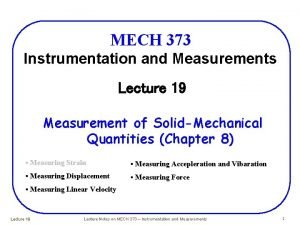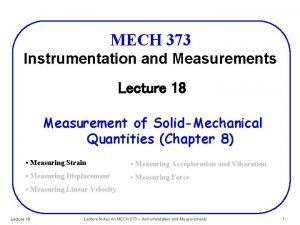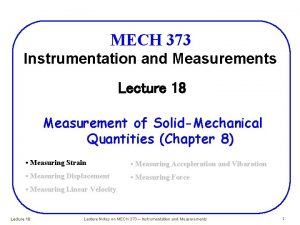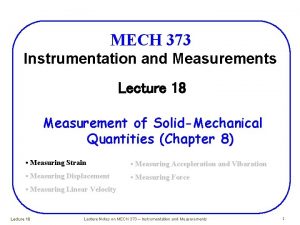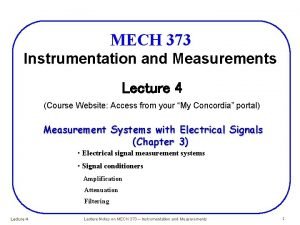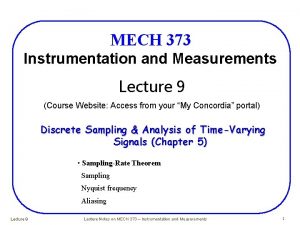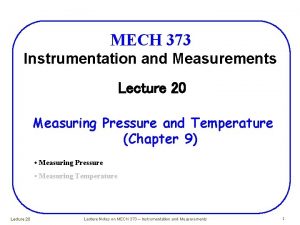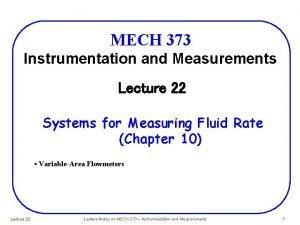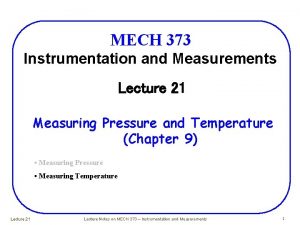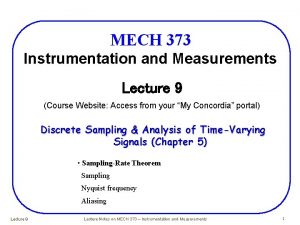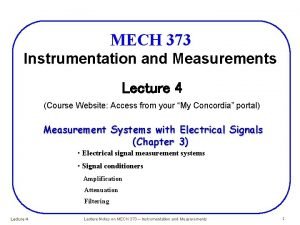MECH 373 Instrumentation and Measurements Lecture 18 Measurement
















- Slides: 16

MECH 373 Instrumentation and Measurements Lecture 18 Measurement of Solid-Mechanical Quantities (Chapter 8) Strain Gauge Signal Conditioning Lecture 18 Lecture Notes on MECH 373 – Instrumentation and Measurements 1

Strain measurements • Measuring gauge resistance before and after loading – Not practical - Significant error– Resistance change in the order of measuring device resolution. • Better approach – Device to measure the resistance change rather than resistance, i. e. , Wheatstone bridge. Lecture 18 Lecture Notes on MECH 373 – Instrumentation and Measurements 2

Wheatstone Bridge • Four identical resistors. • Voltages at points B and D – same – V 0 = 0. 0, bridge = balance. • Active strain gauge R 3 , Load R 3 – bridge is unbalanced and V 0 ≠ 0. 0. • Adjust R 2 – equal to R 3, then V 0 = 0. 0 – bridge is balanced – Amount of adjustment = change of resistance in R 3. DAS. Lecture 18 Lecture Notes on MECH 373 – Instrumentation and Measurements 3

Strain measurements • Modern computer DAS – – Balance the bridge initially. – No need to re-balance it when the active gauge under-strained. – Output voltage proportional to change in gauge resistance. (later slides) Lecture 18 Lecture Notes on MECH 373 – Instrumentation and Measurements 4

Wheatstone bridge Lecture 18 Lecture Notes on MECH 373 – Instrumentation and Measurements 5

Strain measurements Lecture 18 Lecture Notes on MECH 373 – Instrumentation and Measurements 6

Strain measurements Lecture 18 Lecture Notes on MECH 373 – Instrumentation and Measurements 7

Strain measurements Lecture 18 Lecture Notes on MECH 373 – Instrumentation and Measurements 8

Strain measurements • In practice, gauges used are not truly identical. • Uncertainty in an order of 0. 1%. • Vo – nonzero even before the strain applied – Offset – Symmetric error. • Adjust the resistor to bring the bridge into initial balance. • If not – subtract it from the actual readings. Lecture 18 Lecture Notes on MECH 373 – Instrumentation and Measurements 9

Strain measurements • To improve the sensitivity of circuit for a given small strain. • Application – Symmetrical loading situations – Same strain but opposite sign – tension and compression – e. g. sensor – load cells. • R 1 and R 3 – Tensile gauges. • R 2 and R 4 – Compressive gauges. • Full bridge = 4 times the quarter bridge. Lecture 18 Lecture Notes on MECH 373 – Instrumentation and Measurements 10

Temperature compensation Lecture 18 Lecture Notes on MECH 373 – Instrumentation and Measurements 11

Temperature compensation • Temperature: – Affect resistivity, hence gauge factor S = d. R/R/εa. – Cause differential thermal expansion = structure and gauge, hence strain without mech. load. • Minimize the temp effects: – Connect R 2 and R 3 in structure with the same temperature. , R 3 = Active gauge, R 2 = dummy (compensating) gauge – Temp change on both R 2 and R 3 in same direction, hence no strain. – (Note, R 2 can be active gauge if strain is equal and opposite to R 3. ) Lecture 18 Lecture Notes on MECH 373 – Instrumentation and Measurements 12

Strain gauge in practical set-up Lecture 18 Lecture Notes on MECH 373 – Instrumentation and Measurements 13

Strain gauge in practical set-up • Required many gauges to measure structure strain/stress. • Separate bridge for each gauge. • Connect output terminals of each bridge to input channels of DAS. • Use common power supply. • R 1 and R 4 = Dummy gauges. • Each active gauge paired with a fixed gauge R 2 (compensating or active). • Bridge always complete. – Continuous recording or switch to screen for monitoring (critical gauges) Lecture 18 Lecture Notes on MECH 373 – Instrumentation and Measurements 14

Example – Quarter bridge Lecture 18 Lecture Notes on MECH 373 – Instrumentation and Measurements 15

Example Full bridge Lecture 18 Lecture Notes on MECH 373 – Instrumentation and Measurements 16
 Ee8403 measurements and instrumentation
Ee8403 measurements and instrumentation Instrumentation and measurements
Instrumentation and measurements Instrumentation and measurements
Instrumentation and measurements Fundamentals of instrumentation and measurement ppt
Fundamentals of instrumentation and measurement ppt 01:640:244 lecture notes - lecture 15: plat, idah, farad
01:640:244 lecture notes - lecture 15: plat, idah, farad Mech 497
Mech 497 Mech in ns
Mech in ns Integral of force
Integral of force Mag ing mech
Mag ing mech Nabil shalabi
Nabil shalabi Stat mech
Stat mech Tds equations
Tds equations Stat mech
Stat mech Mag ing mech
Mag ing mech Microstates in thermodynamics
Microstates in thermodynamics Rhizomoidy
Rhizomoidy Mech robotix
Mech robotix
